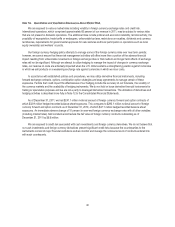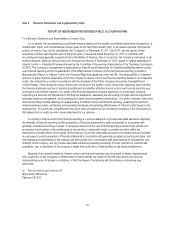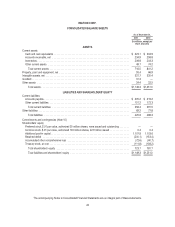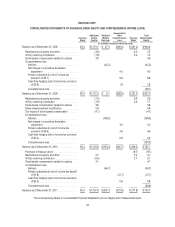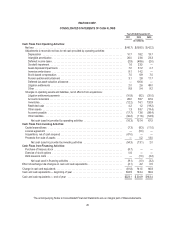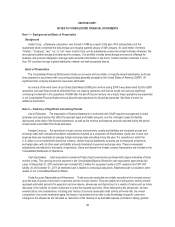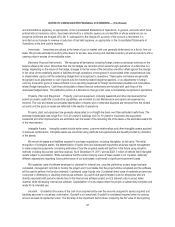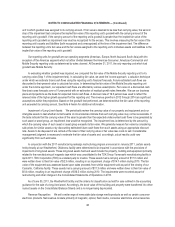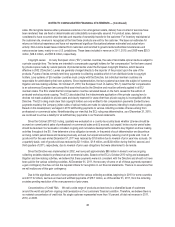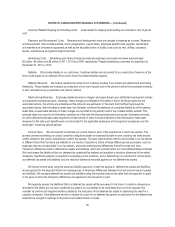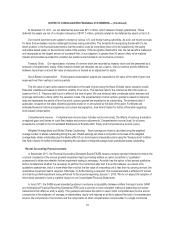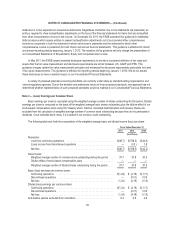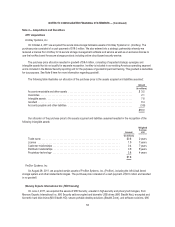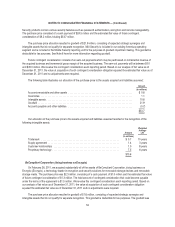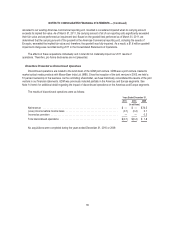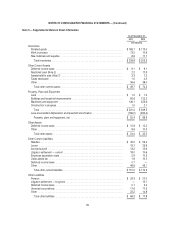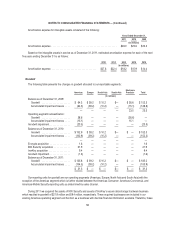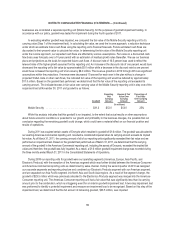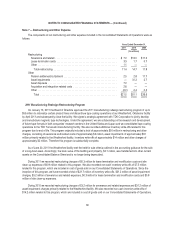Memorex 2011 Annual Report Download - page 53
Download and view the complete annual report
Please find page 53 of the 2011 Memorex annual report below. You can navigate through the pages in the report by either clicking on the pages listed below, or by using the keyword search tool below to find specific information within the annual report.NOTES TO CONSOLIDATED FINANCIAL STATEMENTS — (Continued)
Inventory Related Shipping and Handling Costs. Costs related to shipping and handling are included in cost of goods
sold.
Research and Development Costs. Research and development costs are charged to expense as incurred. Research
and development costs include salaries, stock compensation, payroll taxes, employee benefit costs, supplies, depreciation
and maintenance of research equipment as well as the allocable portion of facility costs such as rent, utilities, insurance,
repairs, maintenance and general support services.
Advertising Costs. Advertising and other promotional costs are expensed as incurred and were approximately
$2 million, $4 million and $6 million in 2011, 2010 and 2009, respectively. Prepaid advertising costs were not significant at
December 31, 2011 or 2010.
Rebates. We provide rebates to our customers. Customer rebates are accounted for as a reduction of revenue at the
time of sale based on an estimate of the cost to honor the related rebate programs.
Rebates Received. We receive rebates from some of our inventory vendors if we achieve pre-determined purchasing
thresholds. These rebates are included as a reduction of our cost of goods sold in the period in which the purchased inventory
is sold, allocated using a systematic and rational method.
Restructuring Reserves. Employee-related severance charges are largely based upon distributed employment policies
and substantive severance plans. Generally, these charges are reflected in the period in which the Board approves the
associated actions, the actions are probable and the amounts are estimable. In the event that the Board approves the
associated actions after the balance sheet date, but ultimately confirms the existence of a probable liability as of the balance
sheet date, a reasonable estimate of these charges are recorded in the period in which the probable liability existed. This
estimate takes into account all information available as of the date the financial statements are issued. Severance amounts
for which affected employees were required to render service in order to receive benefits at their termination dates were
measured at the date such benefits were communicated to the applicable employees and recognized as expense over the
employees’ remaining service periods.
Income Taxes. We are required to estimate our income taxes in each of the jurisdictions in which we operate. This
process involves estimating our actual current tax obligations based on expected taxable income, statutory tax rates and tax
credits allowed in the various jurisdictions in which we operate. Tax laws require certain items to be included in our tax returns
at different times than the items are reflected in our results of operations. Some of these differences are permanent, such as
expenses that are not deductible in our tax returns, and some are temporary differences that will reverse over time.
Temporary differences result in deferred tax assets and liabilities, which are included within our Consolidated Balance Sheets.
We must assess the likelihood that our deferred tax assets will be realized and establish a valuation allowance to the extent
necessary. Significant judgment is required in evaluating our tax positions, and in determining our provision for income taxes,
our deferred tax assets and liabilities and any valuation allowance recorded against our net deferred tax assets.
We record income taxes using the asset and liability approach. Under this approach, deferred tax assets and liabilities
are recognized for the expected future tax consequences of temporary differences between the book and tax basis of assets
and liabilities. We measure deferred tax assets and liabilities using the enacted statutory tax rates that are expected to apply
in the years in which the temporary differences are expected to be recovered or paid.
We regularly assess the likelihood that our deferred tax assets will be recovered in the future. A valuation allowance is
recorded to the extent we conclude a deferred tax asset is not considered to be more-likely-than-not to be realized. We
consider all positive and negative evidence related to the realization of the deferred tax assets in assessing the need for a
valuation allowance. If we determine we will not realize all or part of our deferred tax assets, an adjustment to the deferred tax
asset will be charged to earnings in the period such determination is made.
50


